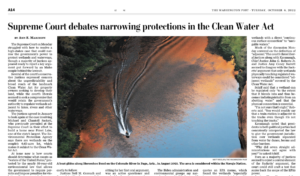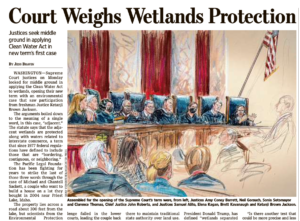Congress has quickly engaged in putting together potential aid packages for farmers that would more than double the Trump administration's $12 billion under the Farmer Bridge Assistance (FBA) Program.
China Dynamics in Focus, While U.S. Supreme Court Considers Scope of the Clean Water Act
Bloomberg writer Jinglu Gu reported yesterday that, “China has curbed exports of corn starch in a signal that the world’s biggest corn importer is likely worried about local supplies.
“The government has asked companies to suspend shipments to stabilize corn prices and contain inflation risks, according to Ma Wenfeng, a senior analyst at the Beijing Orient Agribusiness Consultant Co. Corn starch is commonly used as an ingredient to thicken soups and sauces or for paper products and adhesives.

“Despite the relatively small volume of exports, the move underscores Beijing’s concerns over grain supplies and rising prices. China imports corn mainly from the US, which may face a smaller harvest this season, and Ukraine, where shipments are choked off after Russia’s invasion. While China produces most of the corn it consumes, poor weather has threatened output.”
In other developments regarding China, Financial Times writer Eleanor Olcott reported this week that, “China’s president Xi Jinping is poised to secure an unprecedented third term as leader at a congress of his Communist party this month, but behind the political theatre a broader shift is playing out.
Demographers predict the world’s most populous country will start to shrink in 2022, a turning point with profound ramifications for its future.
The FT article explained that, “While Xi is clearly in the political ascendancy, the economic tools at his disposal are increasingly constrained by a property sector meltdown, the damage to consumer confidence caused by successive coronavirus lockdowns, and local government fiscal shortfalls.

“The rapid ageing of China’s population — a process that will accelerate during Xi’s third term — will further chip away at Beijing’s powers to stimulate growth and manage economic crises.”
Meanwhile, Bloomberg writer Max de Haldevang reported yesterday that, “Mexico aims to cut the cost of 24 basic goods by curbing food exports and extending a pact with major companies in the latest attempt to tame soaring consumer prices.
“The government wants to cut prices for the key goods by 8% from their average peak, through February 2023, Finance Minister Rogelio Ramirez de la O said Monday.
“The government will pause exports of goods including white corn, beans and sardines, as well as scrap metal used for food cans, Ramirez said. It will also suspend requirements such as tariffs and other import barriers for firms that agreed to the deal, he said.”
In market news focused on agricultural production, Reuters writer Ana Mano reported yesterday that, “Excess rains in some areas of Brazil have slowed sowing of the country’s 2022/2023 soybean crop, according agribusiness consultancy AgRural on Monday.
“As of last Thursday, the total area planted with the oilseed reached 3.8% in the world’s largest producer of soybeans. This compares with 4.1% a year ago, according to AgRural.”
Also yesterday, Reuters writer Polina Devitt reported that, “Farmers in Russia have accelerated winter wheat sowing after recent rain eased dry soil conditions in some regions, the Russia-focused Sovecon consultancy said on Monday.”
And today, Reuters writer Pavel Polityuk reported that, “The pace of sowing winter wheat in Ukraine for the 2023 harvest is three times lower than last year’s figures, the data provided by the agriculture ministry showed on Tuesday.
“Farms have sown 1.1 million hectares of winter wheat as of Oct. 3, or 27% of the expected area, compared with 3.1 million hectares sown at the same date in 2021, the data showed.”
With respect to the U.S., Reuters writer Naveen Thukral reported today that, “The U.S. corn harvest was 20% complete as of Sunday, the U.S. Department of Agriculture (USDA) said in a weekly crop progress report on Monday…[and]…the soybean harvest was farther ahead at 22% complete, surpassing the average analyst estimate of 20% but behind the five-year average of 25%.”
In separate news with ramifications for U.S. farmers, Ann E. Marimow reported in today’s Washington Post that, “The Supreme Court on Monday struggled with how to resolve a high-stakes case that could narrow the government’s power to protect wetlands and waterways, though a majority of justices appeared ready to reject a key argument put forward by an Idaho couple behind the lawsuit.”
The Post article stated that,
At issue now is how courts should determine what counts as ‘waters of the United States,’ protected by the nearly 50-year-old environmental law that allows the government to require permits and impose penalties for violations. If the court sides with the Idaho property owners, environmental advocates say about half of all wetlands and roughly 60 percent of streams would no longer be federally protected.
Marimow added that, “The Biden administration and environmental groups say narrowing the reach of the law would undermine the government’s ability to protect wetlands that are separated from a river, for instance, by a small dune but still affect a river’s chemical, physical and biological integrity.”

Wall Street Journal writer Jess Bravin reported in today’s paper that, “The arguments boiled down to the meaning of a single word, in this case, ‘adjacent.’ The statute says that the adjacent wetlands are protected along with waters related to interstate commerce, a term that since 1977 federal regulations have defined to include those that are ‘bordering, contiguous, or neighboring.'”

And DTN writer Todd Neeley reported yesterday that, “The court has been asked to answer a narrow question: Do wetlands lose protection by the Clean Water Act if they’re separated from other waters by barriers?
“A new waters-of-the-U.S. definition in the works at EPA is expected to cement into law the so-called ‘significant-nexus‘ test in determining whether wetlands are jurisdictional.
“Waters with a significant nexus are described as those either alone or in combination with similarly situated waters in the region that significantly affect the chemical, physical or biological integrity of waters of the U.S.
“Currently, the EPA declares wetlands to be jurisdictional if they are ‘adjacent‘ to navigable waters, without really defining the term.”
Neeley added that, “Agriculture and other interests, federal lawmakers and others have asked the agencies to hold off on the ongoing rulemaking until the Supreme Court decision is rendered.”
Elsewhere, Hayley Smith reported in today’s Los Angeles Times that, “California’s drought has become the state’s driest three-year period on record, surpassing that of 2013-15 — and a fourth dry year is looking increasingly likely, officials said Monday.”

Today’s article noted that, “Jeanine Jones, drought manager at the Department of Water Resources, said many agricultural users also experienced significant cuts this year. The state cut allocations from Feather River water rights settlement contractors by 50%, and the Central Valley Project allocated no water to many of its agricultural contractors. Significant reductions in rice acreage this year could have unintended consequences for birds that rely on flooded rice fields during their fall migration, she said.”





